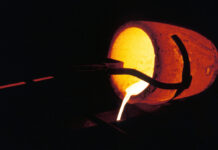
SHARES in Pan African Resources, a small gold miner with a secondary JSE listing, have been on a tear this year. The stock is about 49% higher but is still capitalised at just under R12bn. Gold Fields, by comparison, at a market capitalisation of about R268bn, is now one of the JSE’s largest locally headquartered companies.
Apart from proving that size isn’t everything, Pan African is starting to attract rerating considerations, largely for producing predictable numbers. Far larger miners than Pan African have failed at the altar of consistency.
Gold Fields recently reported a hefty 51% year-on-year increase in first-quarter costs while AngloGold Ashanti’s sought-after rerating in New York rests on its ability to sustainably match the cash costs of its rivals Newmont and Barrick Gold.
Pan African, however, has barely strayed from its 180,000 to 190,000 ounce annual production track record and, according to a report by Investec Securities, has one of the best track records for grade consistency. In an environment of vaulting gold prices, extracting the same or better grams of gold per ton of rock, the normal measure of grade, is critical in maintaining margin. As pointed out recently on Miningmx, costs will eventually start to catch up with South Africa’s gold miners.
In a comparison of grades between 2019 and 2023, Pan African ranked with Gold Fields as the most consistent with the least evidence of “high grading”, a tactic of seeking out high grades to inflate performance. Pan African has the best production profile of the JSE’s gold shares, and the best all-in sustaining cost outlook, the measure of miners’ total costs including expansion capital. This is critical in a depleting resource industry.
As a relatively small miner operating mature mines in Mpumalanga (Barberton Mines and Evander Mines), bumps in production and the risk of resource depletion can hit Pan African hard. So it is critical for it to commission its R2.5bn Mintails project, west of Joburg, in December as planned. In a third-quarter production update, Pan African said it would achieve just that. It also announced plans to expand the project from 50,000 oz a year to 60,000 oz a year pending a feasibility study of the “Soweto Cluster” resource, estimated to cost R2bn in capital.
Initiating coverage in mid-April, Canadian bank Canaccord Genuity has forecast Pan African’s gold production at about 238,000 oz a year by 2027 as a result of Mintails. It forecasts a reduction in costs and expanded margins in the coming three to four years as well as $100m in free cash flow from 2026. This will trigger a “dramatic” improvement in the firm’s balance sheet position, peaking this year at about $90m.
Canaccord analysts Tim Huff and Alex Bedwany say: “We think this will enable higher dividends to be considered as soon as financial 2025 and further growth investments like Egoli (an already announced growth prospect from Barberton Mines) as soon as financial 2026.” Citing its London Stock Exchange price, currently 25p a share, they set a price target of 31p a share.
What can go wrong? Plenty, says Arnold van Graan of Nedbank Securities. While admitting he was wrongly sceptical of gold equities earlier this year, on strong appreciations, he still warns investors not to get “sucked in” to a heady market. In a May 10 note to clients, he wrote that they ought to be wary of growing capital demands as gold miners try to grow into a bull market.
“As a result, the likelihood of sharply rising capex is even more pronounced during this cycle,” he says of the JSE’s gold shares in general. “We therefore expect a sharp increase in growth capex on the back of higher gold prices, which could weigh on cash flows.” He is neutral on Pan African, however.











